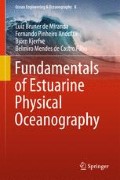Abstract
As estuaries are three dimensional and time dependent, numerical models have been developed to overcome the simplifications inherent to the already studied analytical models (simple geometry, steady-state) and calculate estuarine circulation and salinity distributions. These models can be numerically integrated at selected grid points spatially distributed in the system domain; the governing partial differential equations use methods of finite-difference or finite-elements in curvilinear horizontal coordinates or sigma vertical coordinates, respectively.
Access this chapter
Tax calculation will be finalised at checkout
Purchases are for personal use only
References
Andutta, F. P. 2011. O Sistema Estuarino dos Rios Caravelas e Peruipe (BA): Observações, Simulações, Tempo de Residência e Processos de Difusão e Advecção. Tese de Doutorado. São Paulo, Instituto Oceanográfico, Universidade de São Paulo. 121 p.
Blumberg, A. F. 1975. A Numerical Investigation into the Dynamics of Estuarine Circulation. Tech. Rept. Chesapeake Bay Institute, The Jonhs Hopkins University. n. 91. 110 p. + Apêndices.
Bryan, K. 1969. A numerical method for the study of the circulation of the world ocean. J. Computational Phys., 4(3):347–376.
Hamrick, J. M. 1992. A Three-dimensional Environmental Fluid Dynamics Computer Code: Theoretical and Computational Aspects. The College of William and Mary, Virginia Institute of Marine Science, Special Report 317, 63 pp.
Hunter, J.R. 1975. A method of velocity interpolation applicable to stratified estuaries. Chesapeake Bay Institute. Special Report 45, The Johns Hopkins University (quoted in Blumberg (1975), p. 68).
Ji, Z-G. 2008. Hydrodynamics and Water Quality. John Wiley & Sons, 676 p.
Lendertsee and Critton, E.C. (1971). A water quality simulation model of well mixed estuaries and coastal seas. Vol. 2. Computational Procedures. Rand Corporation, Report R-708-NYC, New York, 53 pp.
Lendertsee, J.J.; Alexander, R.C. & Liu, S-K. 1973. A three dimensional model for estuaries and coastal Seas, V. 1. Principles of Computation. The Rand Corporation. Santa Monica, CA. No. R-1417-OWRR, 57 p.
McDowell, D.M. & O’Connors, B.A. 1977. Hydraulic Behaviour of Estuaries. John Wiley & Sons, N.Y. 292 p.
Nicholson, J., Broker, I., Roelvink, J.A., Price, D., Tanguy, J.M., Moreno, L. (1997). Intercomparison of coastal area morphodynamic models. Coastal Engineering, 31(1–4):97–123.
Pereira, M. D.; Siegle, E.; Miranda, L. B. & Schettini, C. A. F. 2010. Hidrodinâmica e Transporte de Material Particulado em Suspensão em um Estuário Dominado pela Maré. Rev. Bras. de Geofísica (RBGf), 28(3):427–444.
Phillips, O.M. 1969. The Dynamics of the Upper Ocean. Cambridge University Press, London.
Richtmyer, R.D. & Morton, K.W. 1967. Difference Methods for Initial Value Problems. Interscience, N.Y., 463 p.
Roache, P.J. 1982. Computational Fluid Dynamics. Hermosa Publishers. Albuquerque, M.N., 446 p.
Schettini & Miranda, L. B. 2010. Circulation and Suspended Particulate Matter Transport in a Tidally Dominate Estuary: Caravelas Estuary, Bahia, Brazil. Braz. J. Oceanogr. 58(1):1–11.
Schuman, F.G. 1962. Numerical Experiments with Primitive Equations. Symposium of Numerical Weather Prediction. Met. Soc. Of Japan, Tokyo. pp. 85–107.
Thatcher, M. L. & Harleman, D. R. F. 1972. Prediction of Unsteady Salinity Intrusion in Estuaries: Mathematical Model and User’s Manual. Massachusetts Institute of Technology, Mass., Rep. MITSG 72–21. 193 p.
Ward Jr., G. & Espey Jr., W. H. 1971. Estuarine modeling: An Assessment. Water Quality Office, Environmental Protection Agency. Control. Research Series. p. 225.
Author information
Authors and Affiliations
Corresponding author
Rights and permissions
Copyright information
© 2017 Springer Nature Singapore Pte Ltd.
About this chapter
Cite this chapter
Bruner de Miranda, L., Andutta, F.P., Kjerfve, B., de Castro Filho, B.M. (2017). Numerical Hydrodynamic Modelling. In: Fundamentals of Estuarine Physical Oceanography. Ocean Engineering & Oceanography, vol 8. Springer, Singapore. https://doi.org/10.1007/978-981-10-3041-3_12
Download citation
DOI: https://doi.org/10.1007/978-981-10-3041-3_12
Published:
Publisher Name: Springer, Singapore
Print ISBN: 978-981-10-3040-6
Online ISBN: 978-981-10-3041-3
eBook Packages: EngineeringEngineering (R0)

